I have been printmaking in a serious way for well over 25 years, and so assumed I knew pretty much all the ways of making a print. To my joy I recently discovered something new! It is called Mokulito, or wood lithography, and it came to light via a couple of artists I follow on Instagram who make wonderful prints. By chance I discovered that this was the method they were using.
It was developed in Japan in the 1970s, and developed some time later for Western printmakers by a Polish father and daughter team called Josef and Ewa Budka. The knowledge I have been using is all gleaned from internet searches and You Tube clips – I am certainly no expert yet, but the process is very straightforward. I have done lithography before, so understand the basic principles, and these are still the same for Mokulito.
The plate is plywood, any size or thickness, but I have been using small (10 x 10 cm) pieces to start with, to get an idea of what will work – or not. First, it has to be sanded with a fine sandpaper, partly to get a nice smooth surface, but also to remove any greasy fingerprints, as any oily marks potentially will take the ink. Then the image is drawn on to the plate, using any oil based medium. I have been using tusche, which is an ink specifically for lithography, and litho pencils. Once I am happy with the image, I wipe some gum arabic over it, and the plate is set aside, preferably for at least 24 hours.
Then, printing time! I set up the press, prepared the inks (which need to be quite runny, so I added linseed oil), put my paper into a water bath, then washed the gum arabic off the plate. The wet plate is then inked up using a soft foam roller. The ink should adhere to the drawn areas and not to the exposed wood, but if any sticks in the wrong places it can be gently wiped away with a wet sponge. Then printed.
I have had a couple of disasters, with two plates no ink would adhere to the drawn image, so I ended up with an image of wood grain. As yet I have no answer to what went wrong, but I was very happy with how most of the others turned out. I decided to make bleed prints using some of my monoprints torn to size to make a background image, so every print was different.
The opportunities are endless – I could also carve into the plate to add white marks if I wanted to. The woodgrain becomes an integral part of the image, giving each one a lovely organic look. Using thin Japanese papers to print on would give new and interesting results too. All the prints need to be made in one session as once the plate dries it will no longer hold the ink, also some drawing media will last longer than others, so there are no possibilities of making huge print runs. I got 10 prints from the silhouette dog, but the line dog was breaking up after seven.
It is so exciting to enter a whole new universe!


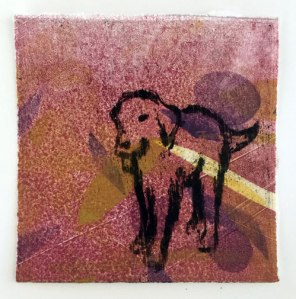
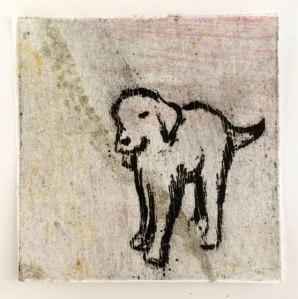
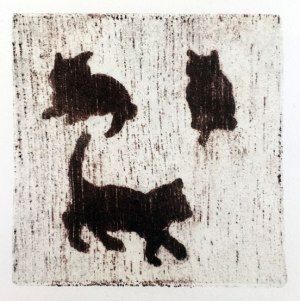

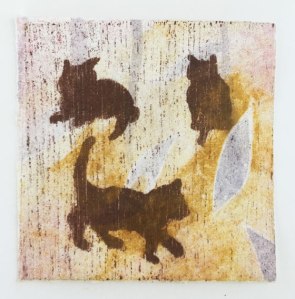


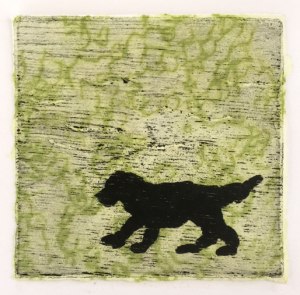
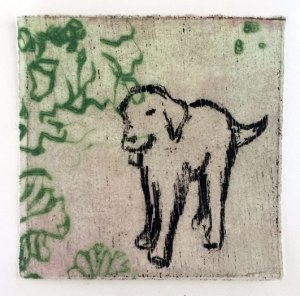
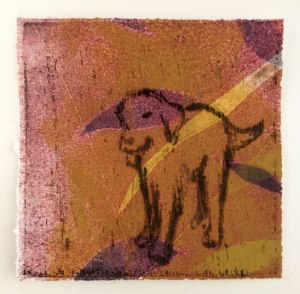
How exciting to find something new! I live the effects that you are creating, and look forward to seeing how far your playing takes you.
LikeLiked by 2 people
I even “love” the effects you are creating!
LikeLike
It is really exciting! Glad you like them so far, I’m feeling really motivated to explore further.
LikeLiked by 2 people
The wonders of Instagram and YouTube! I like the way the woodgrain becomes part of the print. I read about this when I was trying tinfoil lithography – you know how easily one thing leads to another – but had forgotten all about it. It will be interesting to see how you take this further.
LikeLiked by 2 people
Yes, I like tot see the wood grain too. When I was searching for information about this I found ‘kitchen lithography’ which I think is your tinfoil lithography. There was one where the plate was prepared using Coca Cola! It’s just amazing what there is out there …
LikeLike
What fun! It’s always great to find new ways of doing things
LikeLiked by 2 people
It is! It makes you think differently, maybe more creatively.
LikeLiked by 1 person
Absolutely!
LikeLiked by 1 person
Hi Anna, well this is exciting. Because I can see the fibre marks of the wood, I immediately connect with fibre of fabric and can therefore visualize these designs on clothing; cotton, linen or wool. They certainly do have a Japanese aesthetic too.
Having just come from autumn/winter Europe, the colours you have chosen would sit perfectly there just now…an autumn palette.
LikeLiked by 2 people
I think there is a Japanese aesthetic too, but I guess that should be, since it is originally a Japanese technique, but somehow that filters through the subject matter to the final outcome. These are just sample images, testers if you like, and most of them will be used for Christmas cards, which links to the European autumn/winter too! Welcome home!
LikeLiked by 1 person
I always enjoy seeing what you are up to Anna! This is really delicious to look at, the textures and colors are gorgeous. What will happen next?!
Are you creating these images in your home studio?
LikeLiked by 2 people
Thanks Cathe – I’m really enjoying the softness of these, and the textures. I have prepared a larger plate which I’ll print on Monday, its going to be a bit different from these little ones. The thing I’m particularly enjoying is the opportunity to draw – these little ones really are just test pieces for the different media I can use to create the image. I’m preparing the plates in my home studio but printing them I the studio I hire each Monday – I could do them on my own press, but its nice to be able to really spread out in the hire space!
LikeLike
I look forward to seeing the next phase from Monday’s creations! Very nice that you can rent space and spread out too!
LikeLiked by 1 person
It will be on Instagram next week if all goes well Cathe!
LikeLike
So interesting! Wow! I love the dog one….looks kind of familiar….dextery even 😉
LikeLiked by 1 person
I can definitely see Dexter in the silhouette dog! I’m enjoying them, so there could well be some more dogs to come!
LikeLike
It is really wonderful to find something new and your “new” are really intriguing. I look forward to learning more about this technique from you.
LikeLiked by 1 person
It is a delicious surprise to learn something new! I’m realising I do have a lot to learn with this one, but I’m certainly enjoying the process!
LikeLike